Humpback Whales are Navigating an Ocean of Change
In late December 2015, Ed Lyman started getting calls from whale watching companies on the island of Hawai‘i. “Ed, how are the whales off Maui?” tour operators were asking. “We’ve never seen them arrive this late.”
Lyman is the large whale entanglement response coordinator for Hawaiian Islands Humpback Whale National Marine Sanctuary. While the sanctuary coordinates and leads the effort to free whales from life-threatening entanglements, it relies heavily on tour operators, fishermen, researchers, and other members of the on-water community to help find and monitor them. That same on-water community plays a major role in monitoring the overall health of and risks to humpback whales throughout Hawai‘i. Lyman works closely with these groups.
So when more tour operators on other islands throughout Hawai‘i let Lyman and the sanctuary know that the whales seemed to be late that season, Lyman started calling around. He wanted to know if the lower sightings were just on a few of the islands, or in other areas in the Hawaiian Islands as well. But every island was reporting the same thing. Even Mexico’s disentanglement network reached out to Lyman, telling him that they were seeing low numbers. “It wasn’t just us,” says Lyman. “Something was happening.”
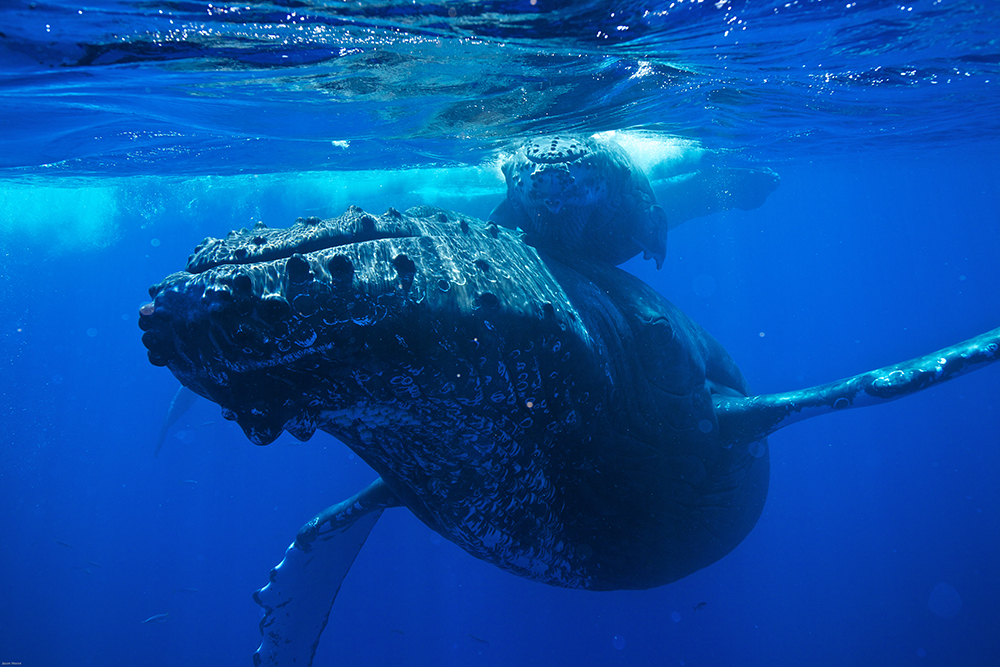
A mother humpback whale supports her calf in the warm waters of Hawaiian Islands Humpback Whale National Marine Sanctuary. Photo: J. Moore/NOAA, under NOAA permit #15240
A whale of a recovery
Each year, thousands of humpback whales migrate between Alaska and Hawai‘i. In parts of Alaska, like Glacier Bay National Park, they feed on huge swarms of small fish and krill throughout the summer. Then, in the winter months, they travel to the warm, shallow waters off Hawai‘i to mate, give birth, and raise their calves.
While in Hawai‘i, humpback whales do not eat. There are a few good reasons for them to forgo the feasts of Alaska during the winter. Primarily, expectant mothers migrate to Hawai‘i to reduce the risks of predation on their newborn calves. While not much will try to eat an adult humpback whale, calves are at risk of predation from orcas. In Hawai‘i, orcas are uncommon. Additionally, whales are born with a relatively thin layer of fat, or blubber. In Hawai‘i, humpback whale calves can stay warm while they nurse and produce the blubber they’ll need to survive the cold waters of Alaska.
Humpback whales range throughout the world’s ocean, migrating between feeding grounds near the poles and calving grounds in tropical waters. In 1973, they were placed on the Endangered Species List, as commercial whaling had significantly reduced their numbers.
The protection appears to have worked. Between 2004 and 2006, 400 researchers from 10 different countries around the world came together to establish population size and migratory patterns for the North Pacific population of humpback whales, and, as a subset of that, the Hawai‘i population. The SPLASH study (Structure of Population, Level of Abundance, Status of Humpback Whales) survey estimated that as of 2006, approximately 10,000 humpback whales utilize Hawai‘i as their breeding and calving area. The survey also indicated that the population was growing at an annual rate of 5.5 to 6.0 percent.
In 2016, thanks to that recovery, the Hawai‘i distinct population segment of the North Pacific population of humpback whales – those whales that feed in Alaska and breed in Hawai‘i – was removed from the Endangered Species List. (Other North Pacific population segments, including the Mexico and Central American distinct population segments, remain on the Endangered Species List.)
The SPLASH growth estimate seemed to be pretty spot-on in the ensuing years. Dr. Rachel Cartwright, emeritus faculty at California State University, Channel Islands, and lead researcher with the Keiki Koholā Project, conducted transect surveys in the ʻAuʻau Channel between Maui and Lānaʻi to determine where mother and calf whales were spending their time. “We had a really nice climb from 2008 to 2013,” she says, with the number of mother and calf pairs increasing over the years. What they observed tracked “with what we would have expected based on that five to six percent” estimate.
But then, everything changed.
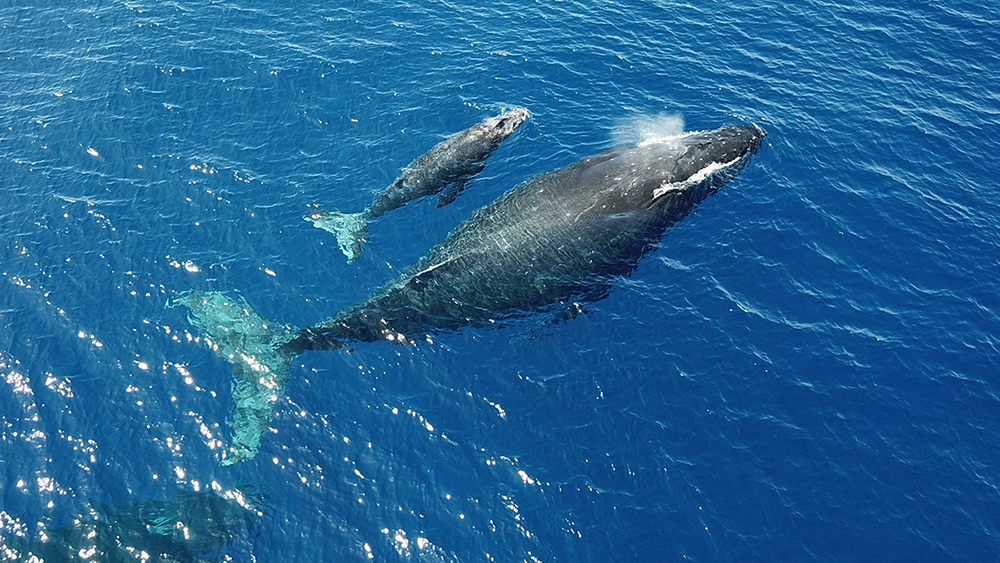
The SPLASH survey conducted between 2004 and 2006 estimated that approximately 10,000 humpback whales visited Hawai‘i each year. Photo: J. Moore/NOAA, under MMHSRP permit #18786-02
A mysterious silence
As the 2015 season progressed, it became more clear to Lyman, Cartwright, and other researchers that the changes in whale sightings weren’t just a temporary fluke. Several researchers shifted their efforts and attention to investigate and quantify the changes in order to help determine what might be going on.
Cartwright, for one, revisited the transects she had surveyed for the first time between 2008 and 2010 and again in 2013 and 2014. “We have random fluctuations,” she acknowledges. “But by the time we got to 2017, we were over 50 percent down from 2014” in terms of the number of different mother and calf pairs they had seen. By 2018, her team was recording an additional 35 percent drop in sighting rates for mother-calf pairs. While she was sighting adult humpback whales in similar numbers as in past surveys, she simply wasn’t seeing many new calves.
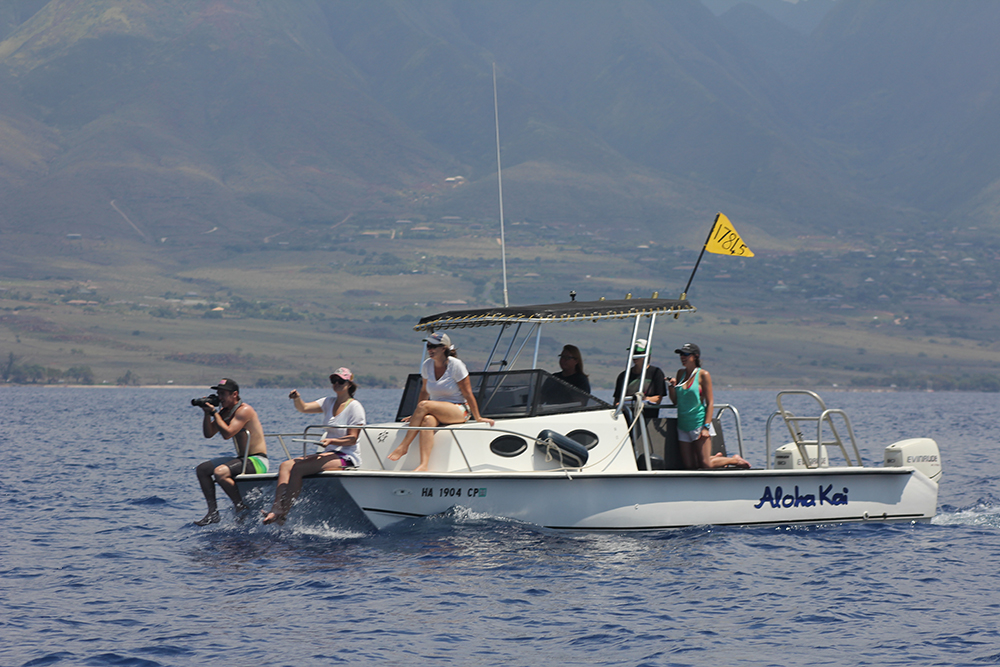
Students and faculty from California State University, Channel Islands have been running systematic transect surveys in the ‘Au‘Au Channel since 2008, monitoring encounter rates for mother and calf pairs. Research is conducted under NMFS Permit #17845. Photo: Keiki Koholā Project
Work by Dr. Marc Lammers helps fill in gaps in data about male adult whales in Maui waters. Lammers is now the research coordinator at Hawaiian Islands Humpback Whale National Marine Sanctuary, but in 2015 he was was president of the Oceanwide Science Institute and an associate research professor at the University of Hawai‘i. Lammers studies whale acoustics, placing underwater microphones called hydrophones in the water and listening in to whale song.
Among humpback whales, only males sing, and only when displaying as part of their competition for potential mates. This behavior results in a steady chorus of whale song being heard in Hawaiian waters between January and April. Beginning in January 2016, Lammers started documenting progressively lower decibel levels of whale chorusing each year. He also noted that the chorus was going quiet earlier in the season. That suggests that either the whales aren’t singing as much, or that they are coming in smaller numbers and leaving Hawaiian waters earlier – or potentially both.
As researchers began putting data together, it became clear that there were fewer whales in other parts of Hawai‘i, also. The Sanctuary Ocean Count is a citizen science program run by the sanctuary in which volunteers gather at sites on the last Saturday of every January, February, and March to count whales. For nearly two decades, counts have been held at the same sites on the islands of O‘ahu, Kaua‘i, and Hawai‘i. The Sanctuary Ocean Count, too, pointed to a decrease in the number of whales beginning in 2016, as did a similar citizen science effort on Maui organized by the Pacific Whale Foundation.
Working in sanctuary waters off the island of Hawai‘i, Christine Gabriele also began seeing a drop in the number of whales starting in 2016. Every February and March since 2000, Gabriele and her colleagues with the nonprofit Hawai‘i Marine Mammal Consortium have conducted systematic shore-based surveys from the Kohala Coast of the island. Between 2010 and 2015, the Hawai‘i Marine Mammal Consortium sighted 477 whales on average each year. But in 2016 and 2017, that average dropped to 261 whales, a decrease of 46 percent. The proportion of calves in the population also dropped dramatically, from 25 calves per season to just six. Because the researchers do a consistent number of surveys each year, the trends in the data accurately reflect change over time.
Gabriele splits her time between Hawai‘i and Alaska, studying the whales. In the spring, summer, and fall, she leaves Hawai‘i to lead Glacier Bay National Park’s humpback whale population monitoring program. What she’s been seeing there concerns her too.
Many whales with a long history in the Glacier Bay area haven’t been showing up to their traditional feeding areas. Not only has the number of whales declined dramatically, but their health and reproduction have suffered too. In 2016 and 2017, whales on the feeding grounds were noticeably thinner than they should be after traveling back from the tropics. “We’ve seen very few calves in the past few years,” says Gabriele. “Perhaps the most worrisome part of what we’ve seen is that the whales that were here all summer were still looking thin toward the end of their feeding season. The number of whales is still low, but the good news is that in 2018 we’ve started seeing fewer whales that appear thin.”
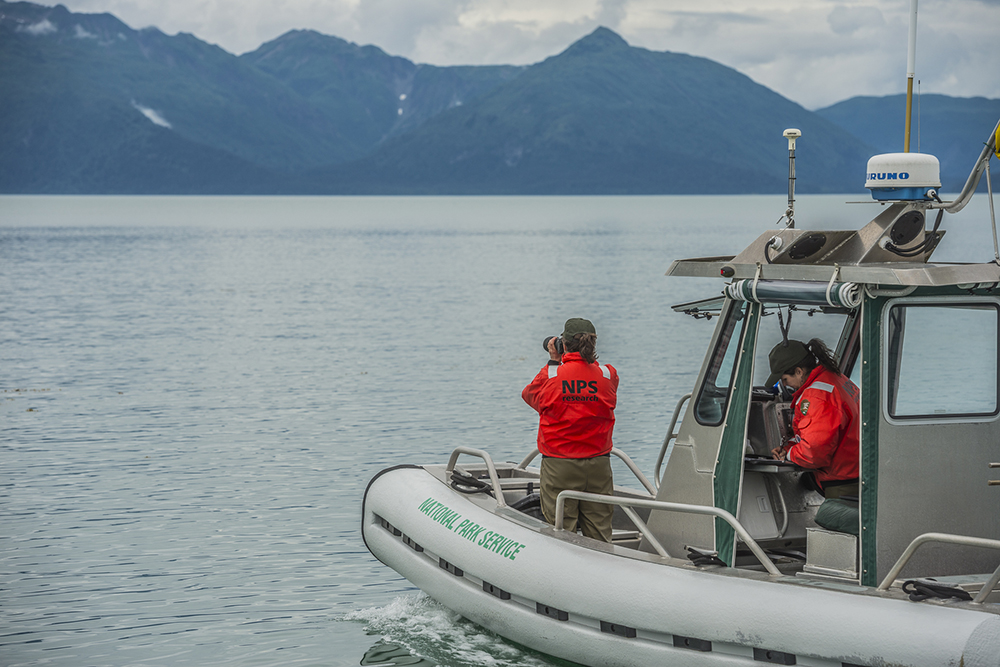
Biologists Christine Gabriele and Janet Neilson carefully approach humpback whales in Glacier Bay National Park aboard the R/V Sand Lance to photograph and observe whales for population monitoring purposes. Sighting histories of individual whales reveal their behavioral and life history traits. Photo: Mark Kelley, under NMFS scientific research permit #15844-02
What is happening?
It’s challenging to know, says Lyman, whether this is a local issue or a large-scale one. “It could be that the whales aren’t coming right in between the islands where we have all the tour boats and where researchers are,” he says. Maybe they’re going farther offshore, and we just aren’t seeing them.
Similarly, Lammers says that hearing fewer males singing “could represent a couple of different things.” It could mean there are simply fewer whales in the vicinity of the hydrophones – which might mean they’re not near Maui, or not in Hawai‘i at all. Or it could mean that males are there, but they’re choosing not to sing, or to sing less. Instead, they could be spending more time actively competing for females. That could be the case; according to Cartwright’s observations, there are fewer pregnant female humpback whales journeying to the typical breeding areas around Hawai‘i to give birth and raise calves.
Regardless of exactly where the whales are, most researchers agree that a likely culprit is food. Over the last several years, three oceanographic conditions have conspired to warm Alaskan waters, which has affected the availability of humpback whale food sources like krill.
The first of these conditions is El Niño. Every two to seven years, warm water in the western tropical Pacific Ocean shifts east. There, it triggers a series of shifts in climate conditions, including warmer-than-average temperatures over the northeastern Pacific – that is, the waters off Alaska.
Then there’s the Pacific Decadal Oscillation, which can be thought of as a sort of long-term El Niño. Every 20 to 30 years, the Pacific Ocean shifts between a “warm” phase and a “cool” one, bringing higher-than-normal sea surface temperatures to the northeastern Pacific.
Finally, there’s the extreme marine heatwave known as The Blob. This mass of warm water showed up in the Pacific Ocean off the coast of the Pacific Northwest and Alaska in 2013, eventually expanding until it was more than 2,000 miles wide. While its cause is unclear, it may be connected to the Pacific Decadal Oscillation, or may be linked to a persistent high pressure weather pattern over the northeastern Pacific Ocean.
These phenomena all hit virtually at once: while The Blob formed in 2013, the Pacific Decadal Oscillation shifted to a warm phase in 2014 and the most recent El Niño cycle began in 2015. This spells bad news for krill. Krill are especially sensitive to warm water. Krill eggs hatch at a narrow temperature range, and rely on strong upwellings to bring nutrients into the surface area of the ocean. Warmer waters reduce the strength of these coastal upwellings, impacting krill production. That leaves humpback whales without their primary food source.
A lack of food could have a number of effects on the whales. One possibility, says Cartwright, is that females may be spending more time in Alaska to build up the adequate fat stores required for reproduction before heading back down to Hawai‘i. But perhaps not: Gabriele notes that there have been fewer whale sightings in parts of Alaska like Glacier Bay National Park, which could mean they’ve gone elsewhere, or that some whales have died. We know very little about disease in free-ranging whales, and she wonders if a harmful algal bloom or other temperature-related factor caused a mortality event that lead to an initial dip in whale numbers. Longer-lasting effects of the initial heatwave seem to have led to skinny whales, seabird die-offs, and notable decreases in salmon, cod, and other Alaska fish stocks.
There’s also the possibility, say Lammers and Lyman, that the population is simply reaching its carrying capacity. A given amount of food can only support a population of a certain size, and the humpback whale population that travels between Alaska and Hawai‘i may have reached its limits. Changing ocean conditions may also have abruptly changed the carrying capacity of their habitats: with less food, the region’s possible whale population size becomes smaller.
Right now, though, these are all ideas. While it’s clear that food availability seems to be impacting humpback whales, researchers are still trying to figure out exactly how it’s impacting them. Continuing the existing monitoring studies and exploring these additional questions will be essential to fully understand what is happening.
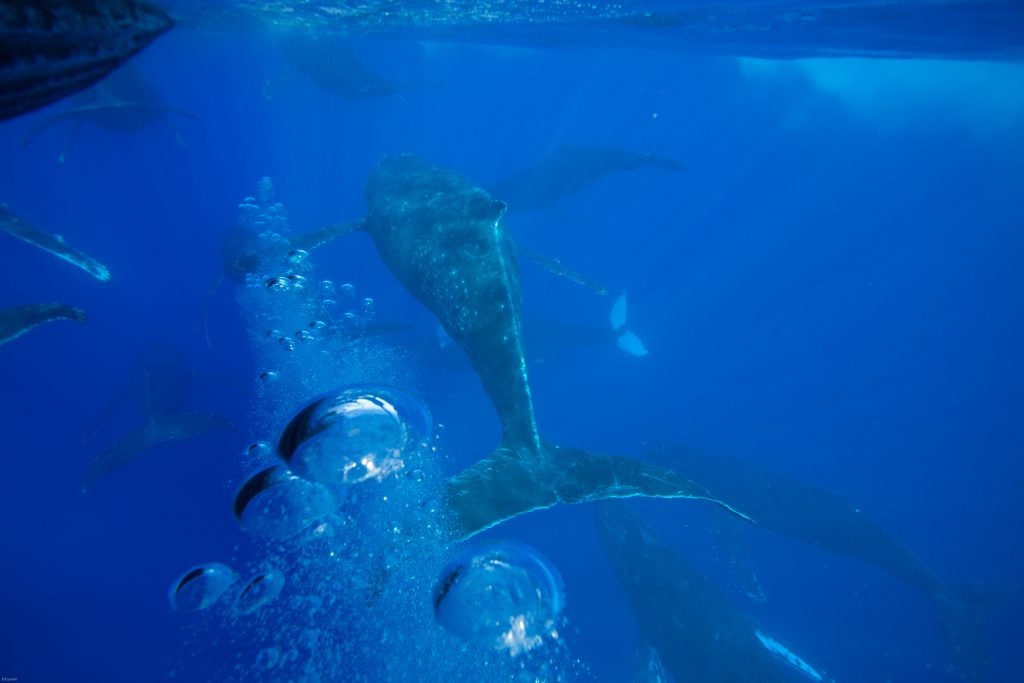
Male humpback whales may be coming to Hawai‘i in smaller numbers, staying for shorter durations, or singing less in the sanctuary because they need to spend more time actively competing for females. Photo: Ed Lyman/NOAA, under NOAA permit #15240
The return of the whales
Although whale sightings have decreased throughout their Hawai‘i breeding and calving grounds during the past three seasons, humpback whales do still visit sanctuary waters in large numbers each year. And while the season may be shorter, visitors are still treated to amazing displays by these majestic creatures.
Plus, if the decrease in whale sightings here is indeed linked to food availability, as Lammers, Lyman, Cartwright, and Gabriele all believe it is, there is a chance these food sources will bounce back. The Blob seems to be dissipating, and El Niño conditions are subsiding. While the Pacific Decadal Oscillation will likely persist for a decade or more, its peak is passing. If the water cools back down, krill and forage fish populations can increase, and the whales will have food again.
Additionally, other populations of humpback whales seem to be thriving. The Antarctic population has seen a humpback whale baby boom in recent years, while feeding activity in Monterey Bay National Marine Sanctuary has surged.
In the meantime, it’s more important than ever to help mother and calf pairs thrive within Hawaiian Islands Humpback Whale National Marine Sanctuary. “Maybe we can realize that they’re having a tough time and give them more space,” hopes Cartwright. Repeated interactions with tour boats, kayakers, and other watercraft can stress whales. “As mum and calf pairs get rarer, they’re going to be surrounded by boats more,” Cartwright points out. “We’ve got fewer animals to dilute it across.” While a whalewatcher may only see one mother and calf pair in a day, that pair may see hundreds of people, interrupting time they would otherwise spend resting or nursing.
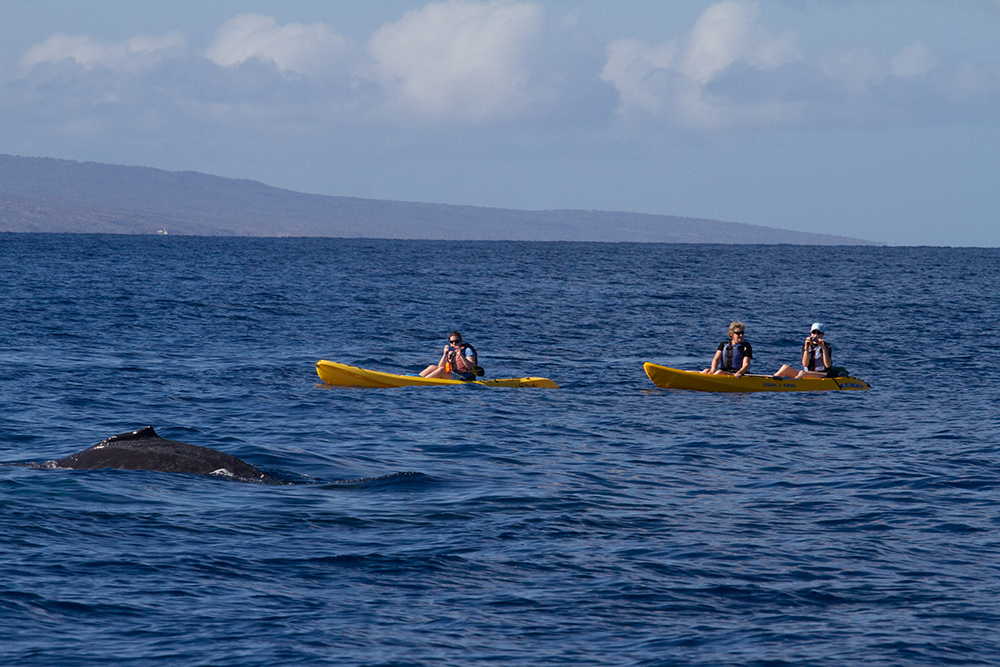
It is now more important than ever to give whales plenty of space in and outside of the sanctuary. Do not approach a humpback whale within 100 yards. This photo depicts kayakers who are too close to a whale. Photo: Ed Lyman/NOAA, under NOAA permit #20311
In addition to encouraging safe whale watching practices and monitoring the population, Hawaiian Islands Humpback Whale National Marine Sanctuary’s “primary objective at this point is to facilitate the discussions among researchers and to bring in resource managers,” says Lammers. “We don’t have enough information, yet, to differentiate between those possible factors that could be contributing to the trends that we’re witnessing.”
The more people working on this issue, the more likely we are to understand it. And the better we understand what’s happening to the whales, the better chance we have of offering a helping hand – or fin.
*(Elizabeth Weinberg is the social media coordinator and writer/editor for NOAA’s Office of National Marine Sanctuaries).
More information
- Hawaiian Islands Humpback Whale National Marine SanctuarySPLASH study
- Sanctuary Ocean CountKeiki Koholā Project
- Oceanwide Science InstituteGlacier Bay National Park
- Hawai‘i Marine Mammal Consortium
- Glacier Bay humpback whale population monitoring – results from the 2017 season
- Glacier Bay National Park: Recent declines in humpback whales in Glacier Bay & Icy Strait – Is their heyday over?









